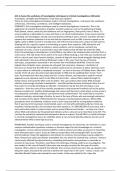AC1.2 Assess the usefulness of investigative techniques in criminal investigations. (20marks)
4 examples, strengths and limitations, must have case studies!!
There are many investigative techniques used in criminal investigations. I will assess the usefulness
of forensics, interviews, surveillance, and intelligent databases.
FORENSICS. One investigative technique used in criminal investigations is forensics. This is the
application of scientific procedures to gather scientific evidence, such as the gathering of bodily
fluids (blood, semen, sweat etc) and evidence such as fingerprints, shoe prints, hairs or fibres. To
ensure evidence is admissible to a case and there is no risk of contamination, crime scenes must be
controlled, and investigators should ensure protective clothing is worn. Forensic scientists will then
examine the evidence collected in a lab and look for elements such as DNA. Forensics appear to be
highly useful as DNA is found in virtually every cell of the human body and is unique to each person,
drawing links to a specific suspect or eliminating a suspect from suspicion. DNA extraction and
analysis has increasingly seen to advance, where evidence can be reanalysed, and with any
indication of crime, a scene is preserved to store the evidence that will later be tested for DNA.
Given this advantage in development, animal DNA is now able to be analysed when extracted from a
crime scene. This had shown to be useful in the case of Brian Keating; a man who was murdered and
left in a church yard. Upon forensic analysis, strands of dog hair were found alongside Keatings body
and had linked to the ones of Daniel McGowen's dog. In this case, from the use of forensic
technique, a perpetrator associated in the murder was immediately identified. Forensics have
helped solve old police cases, proving not only guilt, but innocence. However, a limitation of
forensics can mean that the DNA from a relative could result to conviction or police attention, even
in cases where an individual is completely innocent – as seen in the case of Collette Aram. After the
murder of the 16-year-old, police had urged people to DNA test by swabbing their mouth. Years
later, Paul Hutchinson who was pulled over for a motor offence, and required to swab his mouth
appeared a near-identical match to the DNA of Aram's killer – where Police looked through his
family history and found the killer to be his father. This case outlines that similar DNA amongst
relatives may wrongly conclude a perpetrator – and that perhaps forensic techniques alone are not
that useful in correctly identifying an offender. A limitation may be that this technique is very
expensive – from the costs of the scientific procedures to the personnel involved such as the police,
forensic scientists etc. Another disadvantage that comes with forensics is that where a crime scene is
not adequately controlled, evidence can become easily contaminated. This could lead to incorrect
evidence creating a miscarriage of justice. As seen in the case of Knox, who was wrongly sentenced
and convicted to the death of Miranda Kercher because of contaminated evidence. Where DNA
procedures were not followed, evidence such as a bra clasp was left for so long before collection
that it was bound to have been contaminated, upon a re-trial with admissible evidence, Knox was
acquitted. Having said this, this technique has been quoted a 1 in 7000,000,000 of inaccuracy and is
seen particularly useful in violent crimes such as sexual offences and murder – as these are crimes
where DNA and evidence by the perpetrator (blood, semen, saliva etc) are most likely to be left. This
can then be extracted, examined and analysed to derive a suspect. Overall DNA is a useful technique
in criminal investigations due to its reliability where it can correctly identify evidence and its use of
advancements which create high accuracy.
INTERVIEWS. Another technique used in criminal investigations are interviews. An interview is a non-
coercive method which questions a witness or forensic expert for their knowledge on a criminal
investigation. An Eye-witness testimony (EWT) is where someone provides an account on what they
have witnessed upon a court. Juries are likely to accept these and overweight EWTs to any other
kind of evidence. Given the application and reliance on memory, this technique may be subject to
flaws. Research by Loftus and Palmer exemplifies this risk, where he claimed that a witness’ memory
can be easily affected by external factors, misleading information and questions to conclude an
account of inaccuracy. Therefore, could deter this technique of being useful to an investigation. This
was evident in the case of Ronald Cotton who was wrongly convicted for the rape of Jennifer
Cannino. When called in to identify the offender from a series of pictures and a line-up, despite none
being her rapist, the police led Cannino to believe her rapist was in the room – and as a result, she
identified Ronald Cotton who looked the most similar. Cotton was jailed for life. Upon the




